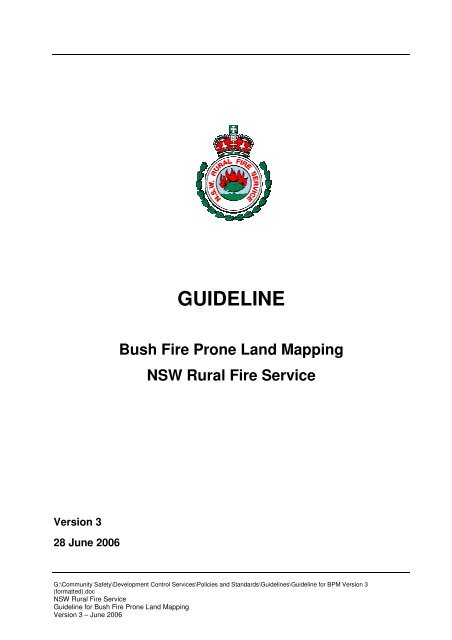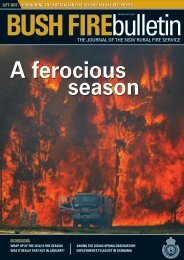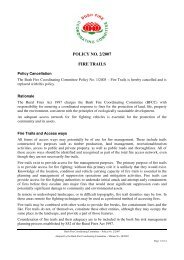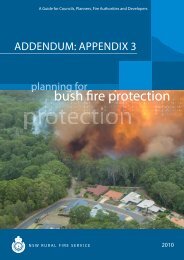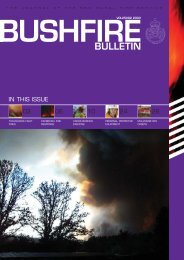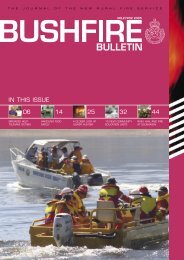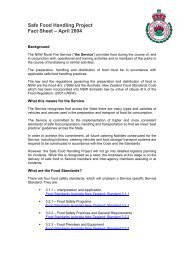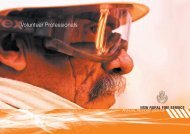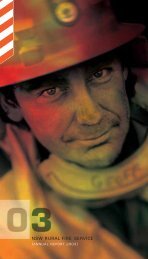GUIDELINE - NSW Rural Fire Service
GUIDELINE - NSW Rural Fire Service
GUIDELINE - NSW Rural Fire Service
Create successful ePaper yourself
Turn your PDF publications into a flip-book with our unique Google optimized e-Paper software.
<strong>GUIDELINE</strong><br />
Bush <strong>Fire</strong> Prone Land Mapping<br />
<strong>NSW</strong> <strong>Rural</strong> <strong>Fire</strong> <strong>Service</strong><br />
Version 3<br />
28 June 2006<br />
G:\Community Safety\Development Control <strong>Service</strong>s\Policies and Standards\Guidelines\Guideline for BPM Version 3<br />
(formatted).doc<br />
<strong>NSW</strong> <strong>Rural</strong> <strong>Fire</strong> <strong>Service</strong><br />
Guideline for Bush <strong>Fire</strong> Prone Land Mapping<br />
Version 3 – June 2006
Table of Contents<br />
1. DEFINITIONS............................................................................................................. 3<br />
2. INTRODUCTION ........................................................................................................ 4<br />
3. SCOPE....................................................................................................................... 4<br />
4. LEGISLATION............................................................................................................ 4<br />
4.1 Ownership/Custodianship............................................................................ 5<br />
5. METHODOLOGY/CRITERIA...................................................................................... 6<br />
5.1 Bush <strong>Fire</strong> Prone Land Mapping ................................................................... 6<br />
5.2 Bush <strong>Fire</strong> Prone Land Map Vegetation Categories...................................... 6<br />
5.3 Bush <strong>Fire</strong> Prone Land Map Vegetation Buffering......................................... 8<br />
5.4 Bush <strong>Fire</strong> Prone Property Map .................................................................... 8<br />
5.4 Bushfire Risk Evacuation Map..................................................................... 9<br />
6. MAPPING REQUIREMENTS ..................................................................................... 9<br />
6.1 Depiction ..................................................................................................... 9<br />
6.2 Format....................................................................................................... 10<br />
6.3 Naming Conventions ................................................................................. 11<br />
6.4 Provision of Source Data........................................................................... 11<br />
6.5 Delivery Mechanisms for Supply of Data to the <strong>Service</strong>............................. 12<br />
7. PRODUCTION.......................................................................................................... 12<br />
Process for the Amendments of and Re-Certification of Bush <strong>Fire</strong> Prone<br />
Land Maps ................................................................................................ 13<br />
7.2 Productions of Maps for Certification ......................................................... 14<br />
8. APPROVAL.............................................................................................................. 15<br />
9. MONITORING AND REVIEW................................................................................... 15<br />
10. APPENDIX ............................................................................................................... 15<br />
10.1 Appendix 1 - Bushfire Prone Depiction Maps............................................. 16<br />
10.2 Appendix 3 - Flowchart.............................................................................. 24<br />
Disclaimer: Any representation, statement opinion, or advice expressed or implied in this<br />
publication is made in good faith on the basis that the State of <strong>NSW</strong>, the <strong>NSW</strong> <strong>Rural</strong> <strong>Fire</strong><br />
<strong>Service</strong>, its agents and employees are not liable (whether by reason of negligence, lack of care<br />
or otherwise) to any person(s) for any damage or loss what so ever which has occurred or may<br />
occur in relation to that person taking or not taking (as the case may be) action in respect of any<br />
representation, statement or advice referred to above.<br />
The RFS reserves the right to review this guideline. The information in this document is subject<br />
to change from time to time and is up to date as at the date stated on the cover of the<br />
document.<br />
<strong>NSW</strong> <strong>Rural</strong> <strong>Fire</strong> <strong>Service</strong> Page 2 of 24<br />
Guideline for Bushfire Prone Land Mapping<br />
Version 3 – June 2006<br />
G:\Community Safety\Development Control <strong>Service</strong>s\Policies and Standards\Guidelines\Guideline for BPM Version 3<br />
(formatted).doc
1. Definitions<br />
Agricultural land - A piece of land not less than 1 hectare in area occupied or used by a<br />
tenant and which is wholly or mostly used or intended to be used for agricultural purposes<br />
including, but not limited to, dairying, pig-farming, poultry farming, viticulture, orchards, beekeeping,<br />
horticulture, vegetable growing, the growing of crops of any kind, or any combination of<br />
any of those things but excluding forestry and plantations (e.g. tea tree).<br />
Bush fire hazard - The potential for land to carry a bushfire, utilising materials or fuels that<br />
can be ignited. The more flammable the material, the greater the hazard.<br />
Bushfire-Prone Area - an area that can support a bushfire or is likely to be subject to<br />
bushfire attack. In general, a bushfire-prone area is an area occurring within 100m of a high or<br />
medium bushfire hazard.<br />
Bush fire prone land mapping - The process of identifying and mapping bush fire prone<br />
land.<br />
Council/s - The local council of an area, and includes an administrator where relevant.<br />
Designated bush fire prone land - Land that falls within or partially within a bush fire prone<br />
area as identified on a certified Bush <strong>Fire</strong> Prone Land Map.<br />
Digital Data – The electronic data-set containing the bush fire prone land polygons and<br />
metadata. This includes the bush fire vegetation buffer dataset (in MapInfo tab file or ESRI<br />
shape file formats and in Long/Lat GDA 94 projection).<br />
<strong>Fire</strong> hazard - Materials that can be ignited. The more flammable the material, the greater the<br />
hazard.<br />
<strong>Fire</strong> hazardous area - An area where the combination of vegetation, topography, weather,<br />
and the threat of fire to life and property create difficult and dangerous problems in a specific<br />
area.<br />
Fuel - Any material such as grass, leaf litter and live vegetation which can be ignited and<br />
sustains a fire. Fuel is usually measured in tonnes per hectare. See Available fuel, Coarse fuel,<br />
Dead fuel, Elevated dead fuel, Fine fuel Ladder fuels, Surface fuels, Total fine fuel.<br />
Managed grasslands - Grass, whether exotic or native, which is regularly maintained at or<br />
below 10cm.<br />
Planning for Bushfire Protection 2001 - A document produced by the <strong>NSW</strong> <strong>Rural</strong> <strong>Fire</strong><br />
<strong>Service</strong> called Planning for Bushfire Protection.<br />
<strong>Service</strong> - The New South Wales <strong>Rural</strong> <strong>Fire</strong> <strong>Service</strong>.<br />
Vegetation groups - Groups of vegetation as per Planning for Bush <strong>Fire</strong> Protection 2001 –<br />
Produced by the <strong>NSW</strong> <strong>Rural</strong> <strong>Fire</strong> <strong>Service</strong>, figure A2.2 – “Pictorial key to the structural forms of<br />
Australian vegetation” and Table A2.1 – “Classification and description of vegetation for the<br />
purposes of bush fire assessment”.<br />
<strong>NSW</strong> <strong>Rural</strong> <strong>Fire</strong> <strong>Service</strong> Page 3 of 24<br />
Guideline for Bushfire Prone Land Mapping<br />
Version 3 – June 2006<br />
G:\Community Safety\Development Control <strong>Service</strong>s\Policies and Standards\Guidelines\Guideline for BPM Version 3<br />
(formatted).doc
2. Introduction<br />
On 1 August 2002, the <strong>Rural</strong> <strong>Fire</strong>s and Environmental Assessment Legislation Amendment Act<br />
2002 (Amendment Act) came into effect. The Act amends both the Environmental Planning and<br />
Assessment Act 1979 and the <strong>Rural</strong> <strong>Fire</strong>s Act 1997 to ensure that people, property and the<br />
environment are more fully protected against the dangers that may arise from bush fires.<br />
The Amendment Act requires councils to map bush fire prone land within their local government<br />
area, which becomes the basis for planning for bush fire protection.<br />
A Bushfire Prone Area is an area that can support a bushfire or is likely to be subject to<br />
bushfire attack. It is appropriate that people living in such areas are advised of such potential.<br />
Research has shown that 85% of houses are lost in the first 100m from bushland and that<br />
ember attack is a significant form of attack on properties.<br />
This Guideline provides the details for mapping bush fire prone land as required under the<br />
Amendment Act. The Guideline is to be used by both the <strong>NSW</strong> <strong>Rural</strong> <strong>Fire</strong> <strong>Service</strong> and councils.<br />
Bush <strong>Fire</strong> Prone Land Maps act as a trigger mechanism for development of land within bushfire<br />
prone areas to ensure where appropriate the bush fire safety provisions are incorporated into<br />
the development..<br />
The Data Sets described within this document use the guidelines for metadata elements<br />
described in: ANZLIC <strong>GUIDELINE</strong>S: CORE METADATA ELEMENTS Version 1 Metadata for<br />
high level land and geographic data directories in Australia and New Zealand<br />
http://www.anzlic.org.au/asdi/metaelem.htm<br />
The Data Sets described are:<br />
• Bush <strong>Fire</strong> Prone Land Map<br />
• Bush <strong>Fire</strong> Risk Evacuation Map<br />
• Bush <strong>Fire</strong> Prone Properties Map<br />
3. Scope<br />
This Guideline applies to all councils who are required to prepare bush fire prone land maps. It<br />
sets out the requirements to enable councils to accurately and consistently map bush fire prone<br />
land. The methodology is one that is to be applied State wide for comparative purposes.<br />
Covers:<br />
Bush <strong>Fire</strong> Prone Land (principle document)<br />
Bush <strong>Fire</strong> Prone Property Map and<br />
Bush <strong>Fire</strong> Risk Evacuation Map<br />
4. Legislation<br />
On 1 August 2002, the <strong>Rural</strong> <strong>Fire</strong>s and Environmental Assessment Legislation Act 2002<br />
(RF&EALA Act) amended the <strong>Rural</strong> <strong>Fire</strong>s Act 1997 (RF Act) and the Environmental Planning<br />
and Assessment Act 1979 (EP&A Act) to provide significant improvements in bush fire safety.<br />
Section 146 of the EP&A Act requires councils, where a Bush <strong>Fire</strong> Risk Management Plan<br />
applies, to prepare bush fire prone land map after consultation with the Commissioner of the<br />
<strong>NSW</strong> <strong>Rural</strong> <strong>Fire</strong> <strong>Service</strong> Page 4 of 24<br />
Guideline for Bushfire Prone Land Mapping<br />
Version 3 – June 2006<br />
G:\Community Safety\Development Control <strong>Service</strong>s\Policies and Standards\Guidelines\Guideline for BPM Version 3<br />
(formatted).doc
<strong>NSW</strong> <strong>Rural</strong> <strong>Fire</strong> <strong>Service</strong>. The Commissioner will designate lands to be bush fire prone within an<br />
area and, when satisfied that the lands have been recorded on a map, will certify the maps as<br />
bush fire prone land maps for the purposes of this or any other Act. Councils are required to<br />
make these maps available for public inspection.<br />
Bush fire prone land is specified in Schedule 4 of Environmental Planning and Assessment<br />
Regulations 2000 as a matters relating to the land and to be identified on s.149 Planning<br />
Certificates. Section 149 of the Environmental Planning and Assessment Act, 1979 requires<br />
that a council may, in a planning certificate, include advice on such other relevant matters<br />
affecting the land of which it may be aware. In this case, the advice is if the land has potential to<br />
be subject to bushfire attack. This is an important mechanism for local government (through the<br />
S149 certificate) to alert people living in areas of the potential for bushfire attack through a<br />
formal planning process and likewise is an important flag for people looking to purchase into<br />
bushfire prone areas so that they may make informed decisions as to the level of risk they may<br />
be faced with.<br />
Section 79BA of the EP&A Act requires that, where development of bush fire prone land occurs,<br />
the consent authority must be satisfied that the development complies with Planning for<br />
Bushfire Protection 2001 produced by the <strong>NSW</strong> <strong>Rural</strong> <strong>Fire</strong> <strong>Service</strong> or has consulted with the<br />
Commissioner.<br />
Section 100B of the <strong>Rural</strong> <strong>Fire</strong>s Act 1997 provides the Commissioner an ability to issue a bush<br />
fire safety authority for residential or rural residential subdivision or for special fire protection<br />
purpose developments of bush fire prone land where the Commissioner believes that the<br />
development complies with standards which provide the development with appropriate<br />
protection measures.<br />
For the purposes of the Building Code of Australia (BCA), designated bush fire prone land maps<br />
are also used to give effect to Australian Standard AS 3959 – 1999 Construction in Bush <strong>Fire</strong><br />
Prone Areas.<br />
4.1 Ownership/Custodianship<br />
Bush <strong>Fire</strong> Prone Land and Property Maps as defined in 6.1 – Depiction will be owned by the<br />
<strong>Service</strong> and held in custody by respective councils.<br />
The <strong>Service</strong> responsibilities with regard to ownership are as follows: -<br />
• The <strong>Service</strong> will provide, manage and maintain a central repository for all bush fire prone<br />
land mapping data across <strong>NSW</strong>.<br />
• The <strong>Service</strong> will maintain metadata for all bush fire prone land data held in the central<br />
repository.<br />
• Ownership of the end output digital data and certified hardcopy maps, will reside with the<br />
<strong>Service</strong>, therefore the custodial relationship is with the <strong>Service</strong>. However, the RFS will<br />
allow each council the authority to release their local government area data for<br />
whichever purpose that they deem to be appropriate.<br />
• The <strong>Service</strong> will manage data held within the central repository in accordance with the<br />
ANZLIC (see schedule 3) metadata guidelines.<br />
• Where the <strong>Service</strong> produces bush fire prone land maps on behalf of councils, the<br />
<strong>Service</strong> will provide the bush fire prone land map dataset in accordance with 6.1 –<br />
Depiction and 6.3 – Format.<br />
<strong>NSW</strong> <strong>Rural</strong> <strong>Fire</strong> <strong>Service</strong> Page 5 of 24<br />
Guideline for Bushfire Prone Land Mapping<br />
Version 3 – June 2006<br />
G:\Community Safety\Development Control <strong>Service</strong>s\Policies and Standards\Guidelines\Guideline for BPM Version 3<br />
(formatted).doc
Council responsibilities with regard to custodianship are as follows: -<br />
• Council will ensure bush fire prone land map outputs are in accordance with this<br />
Guideline.<br />
• Council wishing to review the Bush <strong>Fire</strong> Prone Land Map should do so in collaboration<br />
with its respective <strong>NSW</strong> <strong>Rural</strong> <strong>Fire</strong> District/Zone/Team. Refer to Section 10 for the<br />
process involving amendments and re-certification.<br />
• Council is to have the Bush <strong>Fire</strong> Prone Land Map available for public inspection at all<br />
times in council offices as pursuant to Section 146 of EP&A Act.<br />
• The Bushfire Prone Land Map shall be reviewed by council in consultation with the<br />
<strong>Service</strong> at least once in every five (5) years from the current certification date pursuant<br />
to Section 146 of EP&A Act.<br />
5. Methodology/Criteria<br />
The methodology for the designation of bush fire prone land is determined by using<br />
basic principles of vegetation mapping.<br />
5.1 Bush <strong>Fire</strong> Prone Land Mapping<br />
Bush fire prone land mapping develops a main spatial dataset.<br />
The Bush <strong>Fire</strong> Prone Land Map is the map produced to comply with section 146 of the<br />
EP&A Act and requires the generation of a spatial dataset consisting of a bush fire<br />
vegetation and buffer dataset as one layer. The bush fire vegetation data is derived<br />
from vegetation classification defined as per 5.2.1 – Bush <strong>Fire</strong> Vegetation Categories.<br />
The bush fire vegetation buffer data is derived as per 5.2.2 – Bush <strong>Fire</strong> Vegetation<br />
Buffering.<br />
The principle criteria for bush fire prone land mapping, at first glance, seem quite<br />
simple. Divide vegetation into 3 groups as per the Planning for Bush <strong>Fire</strong> Protection<br />
document and apply appropriate buffering as per the legislation. However, there are<br />
some exceptions to these criteria, which are explained in the following methodology.<br />
5.2 Bush <strong>Fire</strong> Prone Land Map Vegetation Categories<br />
This section defines the methodology and criteria for determining the bush fire<br />
vegetation layer of the dataset.<br />
<strong>NSW</strong> <strong>Rural</strong> <strong>Fire</strong> <strong>Service</strong> Page 6 of 24<br />
Guideline for Bushfire Prone Land Mapping<br />
Version 3 – June 2006<br />
G:\Community Safety\Development Control <strong>Service</strong>s\Policies and Standards\Guidelines\Guideline for BPM Version 3<br />
(formatted).doc
The methodology for the determination of vegetation is as follows: -<br />
1 Determine vegetation groups, regardless of whether the vegetation is<br />
on private or public tenure, using Planning for Bushfire Protection<br />
2001, figure A2.2 – “Pictorial key to the structural forms of Australian<br />
vegetation” and Table A2.1 – “Classification and description of<br />
vegetation for the purposes of bush fire assessment” ensuring<br />
vegetation is classified into three main “Vegetation Groups” 1, 2 and 3.<br />
2 Vegetation Groups are: -<br />
Vegetation Group 1 – Forest<br />
Vegetation Group 2 – Woodlands, heaths and wetlands<br />
Vegetation Group 3 – Moist rainforests, shrubland, open woodlands,<br />
mallee and grasslands.<br />
3 Once vegetation classes have been determined and mapped across a<br />
council area, application of bush fire vegetation categories to the<br />
vegetation groups must be completed. The following Vegetation<br />
Groups relate to bush fire vegetation categories as follows: -<br />
Vegetation Groups 1 and 2, greater than 1 hectare – Veg. Category 1<br />
Vegetation Group 3, greater than 1 hectare – Veg. Category 2<br />
Areas of Vegetation Groups 1 and 2, less than 1 hectare that are<br />
within, or partially within 100m lateral separations from a bush fire<br />
vegetation category 1, or that are within, or partially within 30m lateral<br />
separation from a bush fire vegetation category 2 are classed as Bush<br />
<strong>Fire</strong> Vegetation Category 2.<br />
4 Vegetation as defined in this clause is excluded from the above<br />
mentioned vegetation groups.<br />
Areas of “Vegetation groups” 1, 2 and 3, less than 1 hectare and not<br />
less than 100m lateral separation from a Bush <strong>Fire</strong> Vegetation<br />
Category 1, or not less than 30m lateral separation from a Bush <strong>Fire</strong><br />
Vegetation Category 2, are excluded; or<br />
Areas of “Managed grassland” including grassland on, but not limited<br />
to, grazing land, recreational areas, commercial/industrial land,<br />
residential land, airports/airstrips and the like are excluded; or<br />
areas of managed gardens and lawns within curtilage of buildings;<br />
managed botanical gardens;<br />
agricultural lands used for annual and/or perennial cropping, orchard,<br />
market gardens, nurseries and the likes are excluded; or<br />
mangroves.<br />
5 Areas of national parks and state forests estate should be mapped as<br />
vegetation category 1 in recognition of the land use and management<br />
regime of these areas.<br />
<strong>NSW</strong> <strong>Rural</strong> <strong>Fire</strong> <strong>Service</strong> Page 7 of 24<br />
Guideline for Bushfire Prone Land Mapping<br />
Version 3 – June 2006<br />
G:\Community Safety\Development Control <strong>Service</strong>s\Policies and Standards\Guidelines\Guideline for BPM Version 3<br />
(formatted).doc
IMPORTANT: Councils have the opportunity to negotiate with the <strong>Service</strong>,<br />
the exclusion of lands not listed above. The <strong>Service</strong> retains the right to<br />
make final decisions regarding excluded areas.<br />
NOTE: The bush fire vegetation dataset should not include any vegetation<br />
excluded by 5.2 (d) above<br />
At the conclusion of this part of the process there will be a spatial dataset<br />
called “Bush <strong>Fire</strong> Vegetation”. (See 6.4 – Naming Conventions)<br />
5.3 Bush <strong>Fire</strong> Prone Land Map Vegetation Buffering<br />
This section defines the methodology and criteria for determining the bush fire<br />
vegetation buffer layer dataset.<br />
Once areas of vegetation have been defined and appropriate bush fire vegetation<br />
categories applied, it is necessary to apply the buffering criteria. Application of<br />
buffering will in effect produce the bush fire prone land map.<br />
The methodology for the determination of bush fire vegetation buffering is as follows: -<br />
Bush <strong>Fire</strong> Vegetation Category 1 – apply a 100 metre external buffer to<br />
each vegetation polygon.<br />
Bush <strong>Fire</strong> Vegetation Category 2 – apply a 30 metre external buffer to<br />
each vegetation polygon.<br />
Buffering of each object may create overlapping polygons. Where the<br />
buffering overlaps the vegetation, the buffer overlap should be removed<br />
to create separate, as opposed to overlapping, polygons within separate<br />
datasets.<br />
The two datasets are to be combined to provide a Bush <strong>Fire</strong> Prone Land<br />
data set. This will be used to define each parcel that is “Designated Bush<br />
<strong>Fire</strong> Prone Land”.<br />
At the conclusion of this process there will be one dataset; comprising of<br />
three parts; Vegetation 1, Vegetation 2, and Buffer.<br />
The outcome of this is the bush fire prone land map.<br />
5.4 Bush <strong>Fire</strong> Prone Property Map<br />
The Bush <strong>Fire</strong> Prone Property Map is defined as each parcel of land that is within, or<br />
partially within, the Bush <strong>Fire</strong> Prone Land Map or in terms of the datasets created, the<br />
areas defined in the bush fire vegetation and bush fire vegetation buffer datasets. This<br />
map is used to inform the public that the land is bush fire prone for the purposes of<br />
Section 149 of the EP&A Act.<br />
The methodology in Section 6.2 provides a complete designated bush fire prone<br />
properties “view” of the council area. This is important in defining all properties<br />
affected by bush fire prone designation whether partially or completely. The<br />
Legislation does not differentiate between the terms “partially within” or “completely<br />
within”. It only deals with land so designated.<br />
<strong>NSW</strong> <strong>Rural</strong> <strong>Fire</strong> <strong>Service</strong> Page 8 of 24<br />
Guideline for Bushfire Prone Land Mapping<br />
Version 3 – June 2006<br />
G:\Community Safety\Development Control <strong>Service</strong>s\Policies and Standards\Guidelines\Guideline for BPM Version 3<br />
(formatted).doc
The Bushfire Prone Land Map depiction should be provided to RFS at the same time<br />
as the Bushfire Prone Map.<br />
5.4 Bushfire Risk Evacuation Map<br />
SEPP Seniors Living Schedule 1 identifies ‘Land shown cross-hatched on the bush<br />
fire evacuation risk map’.<br />
The Bushfire Risk Evacuation Map is held by the Department of Planning. A copy of<br />
this map also needs to be provided to the <strong>Rural</strong> <strong>Fire</strong> <strong>Service</strong>.<br />
6. Mapping Requirements<br />
These mapping requirements are necessary to ensure a coordinated and<br />
standardised approach to bush fire prone land mapping. These requirements only<br />
apply to mapping outputs, not to structures or formats within local council database<br />
environments.<br />
6.1 Depiction<br />
It is important to maintain a consistent presentation to the maps. The depiction as<br />
stated here is not software specific, however it is generic and can be applied to all<br />
GIS software.<br />
An example of a completed bush fire prone land map is provided. See Figure 1 below.<br />
Figure 1<br />
<strong>NSW</strong> <strong>Rural</strong> <strong>Fire</strong> <strong>Service</strong> Page 9 of 24<br />
Guideline for Bushfire Prone Land Mapping<br />
Version 3 – June 2006<br />
G:\Community Safety\Development Control <strong>Service</strong>s\Policies and Standards\Guidelines\Guideline for BPM Version 3<br />
(formatted).doc
Veg Category 1 polygons shall be coloured solid orange without a borderline.<br />
Veg Category 2 polygons shall be coloured solid yellow without a borderline.<br />
Bush <strong>Fire</strong> Vegetation Buffer polygon objects shall be coloured solid red without a<br />
borderline.<br />
Schedule 1 shows examples of the Bushfire Prone Land Map. Their specifications<br />
follow in the methodology.<br />
6.2 Format<br />
When Councils send bush fire prone land and property map layers to the <strong>Service</strong> the<br />
data must be in accordance with the following:<br />
Bushfire Prone Land Map<br />
(a)<br />
(b)<br />
(c)<br />
(d)<br />
(e)<br />
(f)<br />
One data set is required, consisting of the Vegetation Categories and<br />
Buffer;<br />
Designated Bush <strong>Fire</strong> Prone Property may be provided as an additional<br />
depiction layer.<br />
Data shall be in MapInfo tab format (preferred), ArcView shape or<br />
MapInfo mid/mif<br />
The data shall include all attached files that are required for display and<br />
storage of the data. Eg. MapInfo tab file including .tab/.dat/.id/.map/.ind<br />
All data provided should utilise Projection GDA 94 or clearly identify<br />
projection used in the meta-data statement.<br />
The data must not be password protected or locked in any way that<br />
denies the <strong>Service</strong> full and complete access to the data.<br />
(g) The required attribute fields for the Bushfire vegetation dataset are: -<br />
Field Name Type Size Example<br />
Vegetation_Category Character 1 1, 2, or 3<br />
BFP_CAT BFP_DESC Character 32 Vegetation<br />
Category 1<br />
LGA_NAME Character 50 Central_Darling<br />
Date_Certified Character 8 ddmmyyyy<br />
Note: Date Certified Field will be filled in by the RFS once the map has been certified<br />
by the Commissioner of the <strong>NSW</strong> <strong>Rural</strong> <strong>Fire</strong> <strong>Service</strong>.<br />
<strong>NSW</strong> <strong>Rural</strong> <strong>Fire</strong> <strong>Service</strong> Page 10 of 24<br />
Guideline for Bushfire Prone Land Mapping<br />
Version 3 – June 2006<br />
G:\Community Safety\Development Control <strong>Service</strong>s\Policies and Standards\Guidelines\Guideline for BPM Version 3<br />
(formatted).doc
(h)<br />
Metadata requirements for the dataset are as per the ANZLIC Core<br />
Metadata Requirements. See Schedule 2 for the ANZLIC Core<br />
Metadata Requirements table. Further definitions and descriptions<br />
regarding ANZLIC Metadata can be found in the complete ANZLIC<br />
Metadata Guidelines: Core metadata elements for geographic data in<br />
Australia - Version 2, February 2001.<br />
6.3 Naming Conventions<br />
(a)<br />
Bush <strong>Fire</strong> Vegetation Dataset files are to use the following naming<br />
convention.<br />
• BFV_CouncilName_DateSaved<br />
BFV – This designates Bush <strong>Fire</strong> Vegetation.<br />
CouncilName – if more than one word do not leave spaces<br />
(e.g. Central_Darling has an underscore between the 2<br />
words).<br />
DateSaved – formatted as DDMMYYYY<br />
Bush <strong>Fire</strong> Prone Land Map file is to use the following naming convention.<br />
(Only if produced)<br />
• BFPL_CouncilName_DateSaved<br />
BFPL – This designates Bush <strong>Fire</strong> Prone Land.<br />
CouncilName – if more than one word do not leave spaces.<br />
DateSaved – formatted as DDMMYYYY<br />
Bush <strong>Fire</strong> Prone Property Map file is to use the following naming<br />
convention.<br />
• BFPP_CouncilName_DateSaved<br />
6.4 Provision of Source Data<br />
BFPP – This designates Bush <strong>Fire</strong> Prone Property.<br />
CouncilName – if more than one word do not leave spaces.<br />
DateSaved – formatted as DDMMYYYY<br />
As part of the supply of data if council wishes to utilise different procedures or source<br />
data this is possible as long as a description of the source data used is provided.<br />
Council will need to provide details such as; the data source, date, currency,<br />
projection.<br />
For example;<br />
Vegetation interpretation was derived from Spot 5 satellite data captured on August<br />
2005.<br />
<strong>NSW</strong> <strong>Rural</strong> <strong>Fire</strong> <strong>Service</strong> Page 11 of 24<br />
Guideline for Bushfire Prone Land Mapping<br />
Version 3 – June 2006<br />
G:\Community Safety\Development Control <strong>Service</strong>s\Policies and Standards\Guidelines\Guideline for BPM Version 3<br />
(formatted).doc
6.5 Delivery Mechanisms for Supply of Data to the <strong>Service</strong><br />
The mechanisms for delivering bush fire prone land and property datasets to the<br />
<strong>Service</strong> are as follows;<br />
Files Sent Electronically<br />
Files sent electronically (i.e. Email) shall have all files saved into WinZip files and attached to<br />
the email. Each WinZip file will include all applicable files. The attached WinZip files shall be<br />
named in accordance with 6.4 – Naming Conventions.<br />
Files sent electronically to;<br />
gis@rfs.nsw.gov.au<br />
Files Sent by Post<br />
Files may be sent to the <strong>Service</strong> via normal postal service. Files sent in this way shall be copied<br />
to a standard Compact Disk (CD). The CD shall be posted in a package that has been<br />
specifically designed for CD postage. CD’s should be a closed session and written for standard<br />
CD reader access. The <strong>Service</strong> will not accept any other delivery mechanism without prior<br />
approval of the Manager Development Control <strong>Service</strong>s.<br />
Files sent by post to: -<br />
The Commissioner<br />
<strong>NSW</strong> <strong>Rural</strong> <strong>Fire</strong> <strong>Service</strong><br />
Att: Bush <strong>Fire</strong> Prone Land Mapping<br />
Development Control <strong>Service</strong>s<br />
Locked Mail Bag 17<br />
Granville <strong>NSW</strong> 2142<br />
7. Production<br />
Section 146 of the EP&A Act, 1979 designates that it is Council’s responsibility to<br />
produce bush fire prone land maps for their area, with approval by the Commissioner<br />
of the <strong>NSW</strong> <strong>Rural</strong> <strong>Fire</strong> <strong>Service</strong>.<br />
While the RFS will continue to assist Councils to revise the maps, the <strong>Service</strong> does<br />
not have the capacity to undertake the mapping or GIS component of the review for<br />
Council. The <strong>Service</strong> is happy to provide input into the review of the Bush <strong>Fire</strong> Prone<br />
Map at a District level, however, Section 146 of the Environmental Planning and<br />
Assessment Act 1979 clearly stipulates that the responsibility for the mapping and<br />
review of the of bush fire prone land is the responsibility of Council.<br />
The RFS district office staff may provide assistance if requested by Council. However,<br />
it is Council’s responsibility to ensure Bushfire Prone Land Mapping is undertaken in<br />
accordance with this document to ensure consistency across the State.<br />
Bush fire prone land maps may also be reviewed in the light of the preparation of<br />
revised bush fire risk management plans by Bush <strong>Fire</strong> Management Committees.<br />
<strong>NSW</strong> <strong>Rural</strong> <strong>Fire</strong> <strong>Service</strong> Page 12 of 24<br />
Guideline for Bushfire Prone Land Mapping<br />
Version 3 – June 2006<br />
G:\Community Safety\Development Control <strong>Service</strong>s\Policies and Standards\Guidelines\Guideline for BPM Version 3<br />
(formatted).doc
Process for the Amendments of and Re-Certification of Bush <strong>Fire</strong> Prone Land<br />
Maps<br />
(a)<br />
(b)<br />
(c)<br />
(d)<br />
(e)<br />
(f)<br />
(g)<br />
(h)<br />
The following is a process for amendments and the re-certification of<br />
bush fire prone land maps for Council.<br />
Council should initially contact the Customer Support Officer for<br />
Development Control <strong>Service</strong>s on (02) 8741 5555 to enquire if there<br />
are any anomalies highlighted for their local government as part of the<br />
initial consultation with the district regarding the map.<br />
Council shall provide to the <strong>NSW</strong> <strong>Rural</strong> <strong>Fire</strong> <strong>Service</strong> the proposed<br />
amendments either as digital data (MapInfo Tab File or ESRI Shape<br />
File, in Long/Lat GDA 94 projection) and/or as drawn amendments on a<br />
copy of the bush fire prone land map.<br />
Council shall include with the digital dataset and/or copy of the Bush<br />
<strong>Fire</strong> Prone Land Map a letter from council requesting the<br />
Commissioner certify council’s map and detailing proposed changes.<br />
Council is also to include an accompanying letter from the <strong>Rural</strong> <strong>Fire</strong><br />
District responsible for that council confirming the proposed<br />
amendments and its concurrence to them.<br />
The <strong>NSW</strong> <strong>Rural</strong> <strong>Fire</strong> <strong>Service</strong> will commence the process of any<br />
amendments received, once they have been agreed to by RFS District<br />
Staff and Council and all information is complete. The 28 day time<br />
period shall begin upon finalisation of the data by Development Control<br />
<strong>Service</strong>s.<br />
The <strong>NSW</strong> <strong>Rural</strong> <strong>Fire</strong> <strong>Service</strong> will endeavor to re-supply a copy of the<br />
map certified by the Commissioner and accompanying digital data to<br />
the council within 28 days of processing the amendments.<br />
Schedule 4 in the appendices indicates the amendment procedures for<br />
councils and <strong>Rural</strong> <strong>Fire</strong> Districts that are wishing to amend their bush<br />
fire prone land map.<br />
All communication regarding bush fire prone land maps is to be<br />
delivered to the <strong>NSW</strong> <strong>Rural</strong> <strong>Fire</strong> <strong>Service</strong> as per Section 6.5<br />
The <strong>Service</strong> will print the final map for Commissioners approval ;<br />
The <strong>Service</strong> will print final BFPL Maps using the standard RFS template and standard<br />
GDS 94LL projection.<br />
Any contentious issues that need to be resolved;<br />
Further liaison between Council staff and the <strong>Service</strong> will be adequately provided for<br />
during and post-production of bush fire prone land maps, if required.<br />
The <strong>Service</strong> will produce 3 hard copies of the certified Bush <strong>Fire</strong> Prone Land<br />
Map (at A0 size for the LGA) to be filed and distributed as follows:<br />
Copy 1 – for RFS, Development Control <strong>Service</strong>s;<br />
Copy 2 – for RFS, District/Zone Manager (or <strong>NSW</strong>FB);<br />
<strong>NSW</strong> <strong>Rural</strong> <strong>Fire</strong> <strong>Service</strong> Page 13 of 24<br />
Guideline for Bushfire Prone Land Mapping<br />
Version 3 – June 2006<br />
G:\Community Safety\Development Control <strong>Service</strong>s\Policies and Standards\Guidelines\Guideline for BPM Version 3<br />
(formatted).doc
Copy 3 – for Council file.<br />
7.2 Productions of Maps for Certification<br />
Councils who wish to produce hard copy Bush <strong>Fire</strong> Prone Land Map outputs for<br />
presentation to the <strong>Service</strong> for certification will:-<br />
(a)<br />
(b)<br />
(c)<br />
Send one hard copy of the Bush <strong>Fire</strong> Prone Map to the <strong>Service</strong>; and<br />
Shall provide digital data as per this guideline document for storage by<br />
RFS.<br />
Shall include on the hard copy map outputs a section called Certification<br />
which shall include the following words and layout:-<br />
CERTIFICATION<br />
For the Purposes of Section 146 (2) of the<br />
Environmental Planning and Assessment Act<br />
1979, this map is hereby certified as being a<br />
Bush <strong>Fire</strong> Prone Land Map of the Local<br />
Government Area of (insert LGA Name) in<br />
<strong>NSW</strong>.<br />
Philip Christian Koperberg AO, AFSM, BEM.<br />
Commissioner<br />
<strong>NSW</strong> <strong>Rural</strong> <strong>Fire</strong> <strong>Service</strong><br />
Date: _____________________<br />
(d)<br />
Include in the map layout a:-<br />
(i) North Arrow<br />
(ii) Legend<br />
(iii) Council name<br />
(iv) Date and time of production<br />
(v) Scale bar and scale text<br />
(vi) Disclaimer/s<br />
Note: All hard copy map outputs shall be in the colours as specified in 6.1 - Depiction.<br />
<strong>NSW</strong> <strong>Rural</strong> <strong>Fire</strong> <strong>Service</strong> Page 14 of 24<br />
Guideline for Bushfire Prone Land Mapping<br />
Version 3 – June 2006<br />
G:\Community Safety\Development Control <strong>Service</strong>s\Policies and Standards\Guidelines\Guideline for BPM Version 3<br />
(formatted).doc
8. Approval<br />
The Commissioner shall certify bush fire prone land maps under section 146 of the<br />
Environmental Planning and Assessment Act 1979 upon advice of the Manager,<br />
Development Control <strong>Service</strong>s<br />
Prior to certifying the bush fire prone land map, the Manager, Development Control<br />
<strong>Service</strong>s is to verify where possible that the map complies with BFPLM guidelines and<br />
that RFS district staff and Council agree that mapping has been undertaken in<br />
accordance with these guidelines.<br />
9. Monitoring and Review<br />
Council having had their bush fire prone land map approved by the Commissioner of<br />
the <strong>NSW</strong> <strong>Rural</strong> <strong>Fire</strong> <strong>Service</strong> should monitor and review the information as presented<br />
on this map to ensure currency and reliability of data depicted, particularly in relation<br />
to changes in cadastral and vegetation data.<br />
Monitoring and review of the bush fire prone land map should consider factors such<br />
as data currency/accuracy/resolution/availability, map production capabilities, and<br />
meeting required certification and approval standards within a 5 year timeframe prior<br />
to the expiration of any currently certified bush fire prone land map.<br />
Council in relation to the timeframe required to meet re-certification requirements<br />
should consider preparing a project implementation schedule so as to comply with the<br />
minimum review approval period.<br />
Council should consider where there are any areas of expanding residential<br />
development leading to vegetation loss, or areas of vegetation regrowth. Bush fire<br />
prone land maps may need to reviewed and prepared on a more frequent basis (eg.<br />
annually).<br />
10. APPENDIX<br />
The following schedules are provided for information of the reader and should not be used as<br />
the only source of detail. For detail and context please read the appropriate documentation as<br />
mentioned in the various sections of this Guideline.<br />
10.1 Appendix 1 Depiction Examples<br />
Additional vegetation reference material can be found in the <strong>Rural</strong><br />
<strong>Fire</strong> <strong>Service</strong> document ‘Planning for Bushfire Protection 2001’ (or<br />
subsequent versions).<br />
10.2 Appendix 2 ANZLIC Core Metadata Requirements<br />
10.3 Appendix 3 BFPLM Process – Flow Chart<br />
<strong>NSW</strong> <strong>Rural</strong> <strong>Fire</strong> <strong>Service</strong> Page 15 of 24<br />
Guideline for Bushfire Prone Land Mapping<br />
Version 3 – June 2006<br />
G:\Community Safety\Development Control <strong>Service</strong>s\Policies and Standards\Guidelines\Guideline for BPM Version 3<br />
(formatted).doc
10.1 Appendix 1 - Bushfire Prone Depiction Maps<br />
All examples are shown including an aerial photograph to assist in interpretation.<br />
a) Example of Category 1 Vegetation and 100m Buffer - (below) Figure 2<br />
Bush <strong>Fire</strong> Prone Land Property Map – (below) Figure 3<br />
<strong>NSW</strong> <strong>Rural</strong> <strong>Fire</strong> <strong>Service</strong> Page 16 of 24<br />
Guideline for Bushfire Prone Land Mapping<br />
Version 3 – June 2006<br />
G:\Community Safety\Development Control <strong>Service</strong>s\Policies and Standards\Guidelines\Guideline for BPM Version 3<br />
(formatted).doc
) Example of Category 2 Vegetation and 30m Buffer - (below) Figure 4<br />
Bush <strong>Fire</strong> Prone Land Property Map – (below) Figure 5<br />
<strong>NSW</strong> <strong>Rural</strong> <strong>Fire</strong> <strong>Service</strong> Page 17 of 24<br />
Guideline for Bushfire Prone Land Mapping<br />
Version 3 – June 2006<br />
G:\Community Safety\Development Control <strong>Service</strong>s\Policies and Standards\Guidelines\Guideline for BPM Version 3<br />
(formatted).doc
Correct Bush <strong>Fire</strong> Prone Land Buffer Example – (below) Figure 6<br />
<br />
Incorrect Bush <strong>Fire</strong> Prone Land Buffer Example – (below) Figure 7<br />
<br />
<strong>NSW</strong> <strong>Rural</strong> <strong>Fire</strong> <strong>Service</strong> Page 18 of 24<br />
Guideline for Bushfire Prone Land Mapping<br />
Version 3 – June 2006<br />
G:\Community Safety\Development Control <strong>Service</strong>s\Policies and Standards\Guidelines\Guideline for BPM Version 3<br />
(formatted).doc
Appendix 2 - ANZLIC Core Metadata Requirements<br />
(Replace LGA in document with your Council’s name).<br />
Metadata<br />
Category<br />
Core Metadata<br />
Element<br />
Description<br />
Dataset<br />
ANZLIC<br />
Identifier<br />
Title<br />
LGA - Bushfire Prone Land<br />
Custodian<br />
Custodian<br />
<strong>NSW</strong> <strong>Rural</strong> <strong>Fire</strong> <strong>Service</strong><br />
Jurisdiction<br />
New South Wales<br />
Description<br />
Abstract<br />
LGA bushfire prone land dataset contains two sets of information.<br />
One is bushfire vegetation, and the other is bush fire vegetation<br />
buffer.<br />
The definition of bushfire vegetation categories is as follows:<br />
• Bush <strong>Fire</strong> Vegetation Category 1 refers to forest, woodlands,<br />
heath, wetlands<br />
• Bush <strong>Fire</strong> Vegetation Category 2 refers to moist rainforests,<br />
shrublands, open woodlands, mallee and grasslands<br />
Buffer was created based on the bush fire vegetation, with the<br />
buffering distance being 100 metres for vegetation category 1, and<br />
30 metres for category 2.<br />
Vegetation excluded from the bush fire vegetation categories are<br />
areas of vegetation less than one hectare, managed grasslands,<br />
managed botanical gardens, agricultural lands and mangroves.<br />
Areas of national parks and state forests estates are identified as<br />
bush fire vegetation category 1.<br />
The legislative context of this dataset is as follows. On 1 August<br />
2002, the <strong>Rural</strong> <strong>Fire</strong>s and Environmental Assessment Legislation<br />
Amendment Act 2002 (Amendment Act) came into effect. The Act<br />
amends both the Environmental Planning and Assessment Act 1979<br />
and the <strong>Rural</strong> <strong>Fire</strong>s Act 1997 to ensure that people, property and the<br />
environment are more fully protected against the dangers that may<br />
arise from bush fires. The Amendment Act requires councils to map<br />
bush fire prone land within their local government area, which<br />
becomes the basis for planning for bush fire protection.<br />
<strong>NSW</strong> <strong>Rural</strong> <strong>Fire</strong> <strong>Service</strong> Page 19 of 24<br />
Guideline for Bushfire Prone Land Mapping<br />
Version 3 – June 2006<br />
G:\Community Safety\Development Control <strong>Service</strong>s\Policies and Standards\Guidelines\Guideline for BPM Version 3<br />
(formatted).doc
Search Word<br />
Bushfire<br />
Geographic<br />
Extent Name<br />
New South Wales, LGA<br />
GEN Category<br />
New South Wales<br />
GEN Custodial<br />
Jurisdiction<br />
New South Wales<br />
GEN Name<br />
New South Wales<br />
Geographic<br />
Extent Polygon<br />
Geographic<br />
Bounding Box<br />
North Bounding<br />
Latitude<br />
-33.888966<br />
South Bounding<br />
Latitude<br />
-33.983732<br />
East Bounding<br />
Longitude<br />
151.042540<br />
West Bounding<br />
Longitude<br />
150.969828<br />
Data<br />
Currency<br />
Beginning date 2001<br />
Ending date 11/08/2003<br />
Dataset<br />
Status<br />
Progress<br />
Maintenance<br />
and Update<br />
Frequency<br />
Complete<br />
As Required<br />
Access<br />
Stored Data<br />
Format<br />
DIGITAL Shapefile, MapInfo TAB file. Name of the files showing the<br />
LGA name and the date of certification.<br />
<strong>NSW</strong> <strong>Rural</strong> <strong>Fire</strong> <strong>Service</strong> Page 20 of 24<br />
Guideline for Bushfire Prone Land Mapping<br />
Version 3 – June 2006<br />
G:\Community Safety\Development Control <strong>Service</strong>s\Policies and Standards\Guidelines\Guideline for BPM Version 3<br />
(formatted).doc
Available<br />
Format Type<br />
DIGITAL Shapefile, MapInfo TAB file.<br />
Access<br />
Constraint<br />
The dataset is available to government agencies and other<br />
organizations. A licence agreement is required to obtain the dataset.<br />
Coordinate<br />
System<br />
Projection<br />
Geographic<br />
Datum GDA 94<br />
Units<br />
Decimal Degrees<br />
Data Quality<br />
Lineage<br />
Vegetation data was captured through supervised classification on<br />
Landsat 7 satellite imagery using software ENVI. The satellite<br />
imagery used was from August to October 2001, with exception for<br />
some limited areas covered by clouds, where satellite imagery up to<br />
six months earlier was used as substitution. The resulting classes<br />
were re-grouped to form the two bush fire vegetation categories. The<br />
riparian vegetation in areas of managed lands was removed from the<br />
dataset.<br />
Data was then exported from ENVI into a DXF format. The data in<br />
DXF format was then imported into MapInfo for further processing.<br />
Areas of vegetation less then one hectare were removed from the<br />
dataset.<br />
A buffer was created based on the bush fire vegetation, with the<br />
buffering distance being 100 metres for vegetation category 1 and 30<br />
metres for category 2.<br />
The resulting draft dataset was then presented for staff of the <strong>NSW</strong><br />
<strong>Rural</strong> <strong>Fire</strong> <strong>Service</strong> and staff of the relevant local government council<br />
to comment, review and ground-truth. Modifications were made to<br />
the bush fire vegetation data according to the feedback, and buffer is<br />
re-created. The dataset was then forwarded again to the local<br />
councils for verification. Upon confirmation of acceptance of the<br />
dataset by the councils, the dataset was then certified by the<br />
commissioner of <strong>NSW</strong> <strong>Rural</strong> <strong>Fire</strong> <strong>Service</strong>.<br />
Bushfire vegetation and bushfire vegetation buffer were processed in<br />
ArcInfo Workstation. The polygons were cleaned, their original<br />
attributes were retained, and the two type of information (vegetation<br />
and buffer) were presented in a single dataset.<br />
Positional<br />
Accuracy<br />
This dataset is sourced from Landsat 7 satellite imagery, which has a<br />
ground resolution of 30 metres.<br />
Attribute<br />
Accuracy<br />
There are three attribute categories, Bushfire Vegetation Category 1,<br />
Bushfire Vegetation Category 2, and Buffer. Vegetation categories 1<br />
and 2 are derived from the classes of the supervised classification of<br />
<strong>NSW</strong> <strong>Rural</strong> <strong>Fire</strong> <strong>Service</strong> Page 21 of 24<br />
Guideline for Bushfire Prone Land Mapping<br />
Version 3 – June 2006<br />
G:\Community Safety\Development Control <strong>Service</strong>s\Policies and Standards\Guidelines\Guideline for BPM Version 3<br />
(formatted).doc
satellite imagery, and buffer is created based on the vegetation<br />
categories.<br />
The attribute of this dataset has been checked by <strong>NSW</strong> <strong>Rural</strong> <strong>Fire</strong><br />
<strong>Service</strong> and the local government councils. Null values and invalid<br />
values have been eliminated, and incorrect values have been<br />
corrected.<br />
Logical<br />
Consistency<br />
All polygons are topologically clean. All bushfire prone land polygons<br />
are labelled with one of the three attribute categories, i.e. Vegetation<br />
Category 1, Vegetation Category 2, or Buffer.<br />
There is an one-to-one relationship between attribute fields<br />
“BFP_CAT” and “BFP_DESC”, with the former contains values “1”,<br />
“2”, or “B”, while the latter contains the description of these values.<br />
Completeness<br />
Completeness of coverage:<br />
LGA Bush <strong>Fire</strong> Prone Land Map is completed.<br />
Completeness of classification:<br />
Complete. All polygons are classified as one of the three<br />
attribute categories.<br />
Completeness of verification:<br />
Complete. The Spatial and Attribute verification of the dataset is<br />
performed by the following methods:<br />
• Local Government Authority confirmation<br />
• selective field verification<br />
• user feedback<br />
Contact<br />
Information<br />
Contact<br />
Organisation<br />
<strong>NSW</strong> <strong>Rural</strong> <strong>Fire</strong> <strong>Service</strong><br />
Contact Position Manager, GIS Unit<br />
Mail Address Locked Bag 17<br />
Locality<br />
Granville<br />
State<br />
<strong>NSW</strong><br />
<strong>NSW</strong> <strong>Rural</strong> <strong>Fire</strong> <strong>Service</strong> Page 22 of 24<br />
Guideline for Bushfire Prone Land Mapping<br />
Version 3 – June 2006<br />
G:\Community Safety\Development Control <strong>Service</strong>s\Policies and Standards\Guidelines\Guideline for BPM Version 3<br />
(formatted).doc
Country<br />
Australia<br />
Postcode 2142<br />
Telephone 8745 5154<br />
Facsimile 8745 5153<br />
Electronic Mail<br />
Address<br />
gis@rfs.nsw.gov.au<br />
Metadata<br />
Date<br />
Metadata Date 12/07/2005<br />
Additional<br />
Metadata<br />
Additional<br />
Metadata<br />
<strong>NSW</strong> <strong>Rural</strong> <strong>Fire</strong> <strong>Service</strong> Page 23 of 24<br />
Guideline for Bushfire Prone Land Mapping<br />
Version 3 – June 2006<br />
G:\Community Safety\Development Control <strong>Service</strong>s\Policies and Standards\Guidelines\Guideline for BPM Version 3<br />
(formatted).doc
10.2 Appendix 3 - Flowchart<br />
BFPLM Process - Flowchart<br />
Development Control<br />
(DCS) receive digital<br />
data set and letters from<br />
Council and<br />
RFS<br />
District.<br />
Map reviewed<br />
by DCS to<br />
ensure all<br />
information<br />
provided.<br />
Is all<br />
information<br />
supplied?<br />
No<br />
Referred back to RFS<br />
District and Council for<br />
negotiation regarding<br />
annomalies and<br />
classifications<br />
Yes<br />
Yes<br />
Satisfied that all<br />
amendments meet<br />
guidelines criteria.<br />
Yes<br />
Clarification and/or<br />
additional details<br />
received by RFS -<br />
DCS<br />
Data provided to<br />
RFS GIS<br />
Processing<br />
timeframe of 28 days<br />
commences<br />
Completed<br />
Map returned<br />
to DCS<br />
End<br />
Map to<br />
Commissioner<br />
of RFS for<br />
Certification<br />
RFS GIS to make<br />
digital data available<br />
to DCS via certified<br />
data folder.<br />
Hardcopy of Maps and<br />
re-certified data resupplied<br />
to Council and<br />
RFS district.<br />
<strong>NSW</strong> <strong>Rural</strong> <strong>Fire</strong> <strong>Service</strong> Page 24 of 24<br />
Guideline for Bushfire Prone Land Mapping<br />
Version 3 – June 2006<br />
G:\Community Safety\Development Control <strong>Service</strong>s\Policies and Standards\Guidelines\Guideline for BPM Version 3<br />
(formatted).doc


